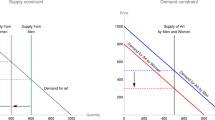Abstract
We test for gender effects in the art market using auction prices for artists who graduated from the Yale School of Art. Yale’s female graduates have significantly fewer auction sales, controlling for their graduating year gender ratio. Conditioning upon sale, works by female artists obtained higher average prices. The results suggest that while institutions and career paths may condition on gender, the market may not.







Similar content being viewed by others
Notes
Interestingly, all three of our working papers appeared at about the same time, using different data and methodologies.
Galenson (2005) notes that “…during the past 5 decades the Yale School of Art has produced a series of graduates who have achieved great success commercially as well as critically.”
Cf. Goetzmann et al. (2016).
Cf. Jacobs (2005).
See Alper and Wassall (2006) for an excellent literature review.
To further address the issue of marital surname changes, we used these 643 name changes to test a potential instrument for probability of name change: length and fraction of vowels in a surname. We found no correlation.
The auction data are from blouinartinfo.com.
This separation is motivated by Rengers (2002)’s “winner-take-all” finding.
p value of 0.0003. Not reported in the table.
Not reported in the table.
As a robustness check, we also perform an OLS with log of average auction price as the dependent variable: the results are qualitatively similar but only significant at the 10% level. Available upon request.
See Fig. 9 in “Appendix” for citation gender ratio by year of citation.
References
Adams, R., et al. (2017). Is gender in the eye of the beholder? Identifying cultural attitudes with art auction prices.
Alper, N. O., & Wassall, G. H. (2006). Artists’ careers and their labor markets. Handbook of the Economics of Art and Culture, 1, 813–864.
Bocart, F., Gertsberg, M., & Pownall, R. A. J. (2018). Glass ceilings in the art market. Available at SSRN 3079017.
Chanel, O., Gérard-Varet, L.-A., & Ginsburgh, V. (1996). The relevance of hedonic price indices. Journal of Cultural Economics, 20(1), 1–24.
Coate, B., & Fry, T. L. R. (2012). Better off dead? Prices realised for Australian paintings sold at auction. In ACEI 2010: proceedings of the 16th international conference on cultural economics 2010. Association for Cultural Economics International.
Edwards, S. (2004). The economics of Latin American art: Creativity patterns and rates of return. No. w10302. National Bureau of Economic Research.
Frank, R. H., & Cook, P. J. (1991). Winner-take-all markets. Working paper, Western University.
Frank, R. H., & Cook, P. J. (1996). The winner-take-all society: How more and more Americans compete for ever fewer and bigger prizes, encouraging economic waste, income inequality, and an impoverished cultural life. Contemporary Sociology, 25(4), 539.
Galenson, D. W. (2005). Anticipating artistic success (or, how to beat the art market): Lessons from history. No. w11152, National Bureau of Economic Research.
Goetzmann, W. N., Jones, P. W., Maggioni, M., & Walden, J. (2016). Beauty is in the bid of the beholder: An empirical basis for style. Research in Economics, 70(3), 388–402.
Hengel, E. (2017). Publishing while female. Are women held to higher standards? Evidence from peer review. https://doi.org/10.17863/CAM.17548.
Jacobs, J. E. (2005). Twenty-five years of research on gender and ethnic differences in math and science career choices: What have we learned? New Directions for Child and Adolescent Development, 110, 85–94.
Korteweg, A., Kräussl, R., & Verwijmeren, P. (2016). Does it pay to invest in art? A selection-corrected returns perspective. Review of Financial Studies, 29(4), 1007–1038.
Rengers, M. (2002). Economic lives of artists: Studies into careers and the labour market in the cultural sector. Dissertation.
Rengers, M., & Velthuis, O. (2002). Determinants of prices for contemporary art in Dutch galleries, 1992–1998. Journal of Cultural Economics, 26(1), 1–28.
Renneboog, L., & Spaenjers, C. (2013). Buying beauty: On prices and returns in the art market. Management Science, 59(1), 36–53.
Rosen, S. (1981). The economics of superstars. The American Economic Review, 71(5), 845–858.
Spaenjers, C., Goetzmann, W. N., & Mamonova, E. (2015). The economics of aesthetics and record prices for art since 1701. Explorations in Economic History, 57, 79–94.
Tsugawa, Y., Jena, A. B., Figueroa, J. F., Orav, E. J., Blumenthal, D. M., & Jha, A. K. (2017). Comparison of hospital mortality and readmission rates for Medicare patients treated by male vs female physicians. JAMA Internal Medicine, 177(2), 206–213.
Acknowledgements
We thank Lesley Baier, Eric Greenleaf, Lisa Kahn, Sharon Oster, Judith Schiff, and all the participants of the Symposium on Art and Gender at Yale School of Management for their comments and suggestions.
Author information
Authors and Affiliations
Corresponding author
Ethics declarations
Conflict of interest
The authors declare that they have no conflict of interest.
Additional information
Publisher's Note
Springer Nature remains neutral with regard to jurisdictional claims in published maps and institutional affiliations.
Appendix
Appendix
See Tables 8, 9, 10, 11, 12, 13 and 14 and Figs. 8, 9, 10 and 11.
Distribution of art prices by gender. a The distributions of log(price) for different gender groups. b–d The distribution of log(price) using the frequencies instead of density for all graduates, graduates before and after 1983, respectively. e The distributions of log(price) for all artists. The dashed line represents the normal distribution
Yale School of Art graduates in the Google Books corpus (for 464 names). a The male/female ratio of citation counts by year of graduation, adjusting for gender ratio of each class. b The same ratio eliminating the observations with the ratio > 25 (3 observations). Dashed line represents the ratio equal to 1. (For many classes, we do not observe any citation, and therefore, this is a scatter plot and not connected.)
Rights and permissions
About this article
Cite this article
Cameron, L., Goetzmann, W.N. & Nozari, M. Art and gender: market bias or selection bias?. J Cult Econ 43, 279–307 (2019). https://doi.org/10.1007/s10824-019-09339-2
Received:
Accepted:
Published:
Issue Date:
DOI: https://doi.org/10.1007/s10824-019-09339-2








